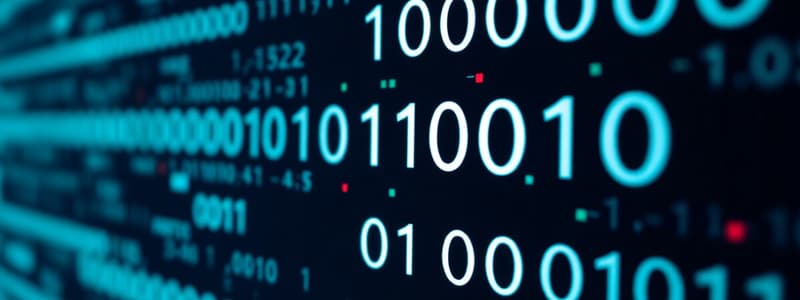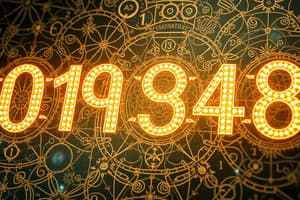Podcast
Questions and Answers
Convert the decimal number 26110 to hexadecimal. What is the correct hexadecimal representation?
Convert the decimal number 26110 to hexadecimal. What is the correct hexadecimal representation?
- 1B5h
- 105h (correct)
- FFh
- 16h
What is the binary equivalent of the hexadecimal value A3C5H?
What is the binary equivalent of the hexadecimal value A3C5H?
- 1100 1000 1101 1101B
- 1010 0011 1100 0101B (correct)
- 1010 0111 1100 0101B
- 1010 0011 0100 0101B
Which of the following represents the octal number 247 in hexadecimal?
Which of the following represents the octal number 247 in hexadecimal?
- A7H (correct)
- 016H
- A6H
- 009H
What is the octal representation of the decimal number 48710?
What is the octal representation of the decimal number 48710?
Convert the binary number 10001011001011B to hexadecimal. What is the resulting hexadecimal value?
Convert the binary number 10001011001011B to hexadecimal. What is the resulting hexadecimal value?
What is the fractional hexadecimal equivalent for the decimal number 36.5328?
What is the fractional hexadecimal equivalent for the decimal number 36.5328?
If the binary number 10110B is converted to decimal, what is the resulting decimal value?
If the binary number 10110B is converted to decimal, what is the resulting decimal value?
What is the 10's complement of the decimal number 23450?
What is the 10's complement of the decimal number 23450?
In converting the fractional part 0.6875 to binary, what binary representation is obtained?
In converting the fractional part 0.6875 to binary, what binary representation is obtained?
Using 9's complement subtraction, what would be the result of subtracting 1000 from 1234?
Using 9's complement subtraction, what would be the result of subtracting 1000 from 1234?
What is the 2's complement of the binary number 1011001?
What is the 2's complement of the binary number 1011001?
Which of the following represents the 16's complement of the hex number 4A30?
Which of the following represents the 16's complement of the hex number 4A30?
What is the correct method to find 9's complement for the number 23450?
What is the correct method to find 9's complement for the number 23450?
When performing 10's complement subtraction of 3000 from 1234, what is the correct answer?
When performing 10's complement subtraction of 3000 from 1234, what is the correct answer?
What will be the 4's complement of the decimal number 224?
What will be the 4's complement of the decimal number 224?
What is the result of applying De Morgan's theorem to the expression (A + B + C)'?
What is the result of applying De Morgan's theorem to the expression (A + B + C)'?
In simplifying the expression a.b + a.(b + c) + b.(b + c), which property is utilized when reducing b.b to 0?
In simplifying the expression a.b + a.(b + c) + b.(b + c), which property is utilized when reducing b.b to 0?
Which form is NOT a canonical form as mentioned in the content?
Which form is NOT a canonical form as mentioned in the content?
What is the simplified form of the expression A'B'C + A'BC + AB'?
What is the simplified form of the expression A'B'C + A'BC + AB'?
When simplifying the function F = AB + (AC)' + AB'C(AB + C), which step eliminates AB or C permanently as contributing factors?
When simplifying the function F = AB + (AC)' + AB'C(AB + C), which step eliminates AB or C permanently as contributing factors?
What does the additive inverse define in arithmetic operations?
What does the additive inverse define in arithmetic operations?
Which of the following correctly represents the multiplication identity property?
Which of the following correctly represents the multiplication identity property?
According to the distributive law, which expression is equivalent to A * (B + C)?
According to the distributive law, which expression is equivalent to A * (B + C)?
What does Theorem 4(Associative) indicate about addition?
What does Theorem 4(Associative) indicate about addition?
In De Morgan’s Theorems, what does (A.B)′ equal?
In De Morgan’s Theorems, what does (A.B)′ equal?
What is the result of applying Theorem 2(b): A * 0?
What is the result of applying Theorem 2(b): A * 0?
Which of the following statements is accurate regarding the properties discussed?
Which of the following statements is accurate regarding the properties discussed?
What is the complementary result of A + A' based on Postulate 5?
What is the complementary result of A + A' based on Postulate 5?
Based on Theorem 6(b), what does A.(A + B) equal?
Based on Theorem 6(b), what does A.(A + B) equal?
What does the Involution theorem state about negation and double negation?
What does the Involution theorem state about negation and double negation?
What is the primary function of a diode array in electronic circuits?
What is the primary function of a diode array in electronic circuits?
Which type of IC classification would include devices with 10,000 to 99,999 circuits?
Which type of IC classification would include devices with 10,000 to 99,999 circuits?
What is a disadvantage of integrated circuits (ICs) mentioned in the context?
What is a disadvantage of integrated circuits (ICs) mentioned in the context?
Which of the following best describes monolithic ICs?
Which of the following best describes monolithic ICs?
Which attribute is NOT associated with diode arrays?
Which attribute is NOT associated with diode arrays?
In the context of scale of integration, which category handles 100 to 9,999 circuits?
In the context of scale of integration, which category handles 100 to 9,999 circuits?
Which of these is a merit of ICs?
Which of these is a merit of ICs?
Which type of IC is formed by inter-connecting individual chips?
Which type of IC is formed by inter-connecting individual chips?
What maximum number of components can ULSI ICs handle?
What maximum number of components can ULSI ICs handle?
Which statement about digital logic ICs does NOT hold true?
Which statement about digital logic ICs does NOT hold true?
Flashcards
Decimal to Hexadecimal
Decimal to Hexadecimal
Converting a number from decimal (base-10) to hexadecimal (base-16) involves repeatedly dividing the decimal number by 16 and keeping track of the remainders. Each remainder represents a hexadecimal digit.
Binary to Decimal
Binary to Decimal
To convert a binary number to decimal, multiply each digit by its corresponding power of 2 and sum the results. The powers of 2 start from the rightmost digit and increase by 1 for each digit to the left.
Decimal to Octal
Decimal to Octal
Converting decimal to octal involves repeatedly dividing the decimal number by 8 and keeping track of the remainders. Each remainder represents an octal digit.
Binary to Hexadecimal
Binary to Hexadecimal
Signup and view all the flashcards
Hexadecimal to Binary
Hexadecimal to Binary
Signup and view all the flashcards
Hexadecimal to Octal
Hexadecimal to Octal
Signup and view all the flashcards
Octal to Hexadecimal
Octal to Hexadecimal
Signup and view all the flashcards
De Morgan's Theorem
De Morgan's Theorem
Signup and view all the flashcards
Product Term
Product Term
Signup and view all the flashcards
Sum Term
Sum Term
Signup and view all the flashcards
Sum of Products (SOP)
Sum of Products (SOP)
Signup and view all the flashcards
Product of Sums (POS)
Product of Sums (POS)
Signup and view all the flashcards
What is a semiconductor diode?
What is a semiconductor diode?
Signup and view all the flashcards
What is the difference between a diode and a rectifier?
What is the difference between a diode and a rectifier?
Signup and view all the flashcards
What is a diode array?
What is a diode array?
Signup and view all the flashcards
How do diode arrays protect electronic circuits?
How do diode arrays protect electronic circuits?
Signup and view all the flashcards
What are Integrated Circuits (ICs)?
What are Integrated Circuits (ICs)?
Signup and view all the flashcards
What are the advantages and disadvantages of ICs?
What are the advantages and disadvantages of ICs?
Signup and view all the flashcards
What is SSI (Small-Scale Integration)?
What is SSI (Small-Scale Integration)?
Signup and view all the flashcards
What is MSI (Medium Scale Integration)?
What is MSI (Medium Scale Integration)?
Signup and view all the flashcards
What is LSI (Large Scale Integration)?
What is LSI (Large Scale Integration)?
Signup and view all the flashcards
What is VLSI (Very Large Scale Integration)?
What is VLSI (Very Large Scale Integration)?
Signup and view all the flashcards
Additive Identity
Additive Identity
Signup and view all the flashcards
Additive Inverse
Additive Inverse
Signup and view all the flashcards
Multiplicative Identity
Multiplicative Identity
Signup and view all the flashcards
Multiplicative Inverse
Multiplicative Inverse
Signup and view all the flashcards
Distributive Law
Distributive Law
Signup and view all the flashcards
Postulate
Postulate
Signup and view all the flashcards
Theorem
Theorem
Signup and view all the flashcards
De Morgan's Theorem (Part 1)
De Morgan's Theorem (Part 1)
Signup and view all the flashcards
De Morgan's Theorem (Part 2)
De Morgan's Theorem (Part 2)
Signup and view all the flashcards
Absorption Law
Absorption Law
Signup and view all the flashcards
2's Complement
2's Complement
Signup and view all the flashcards
10's Complement
10's Complement
Signup and view all the flashcards
16's Complement
16's Complement
Signup and view all the flashcards
9's Complement
9's Complement
Signup and view all the flashcards
R's and (R-1)'s Complement
R's and (R-1)'s Complement
Signup and view all the flashcards
9's Complement Subtraction
9's Complement Subtraction
Signup and view all the flashcards
10's Complement Subtraction
10's Complement Subtraction
Signup and view all the flashcards
8's Complement
8's Complement
Signup and view all the flashcards
Binary Representation
Binary Representation
Signup and view all the flashcards
Study Notes
Course Information
- Course Title: Digital Logic Design
- Course Code: IFT 211
Number Systems
- Computers use the binary (base 2) number system
- Binary numbers are represented using 0s and 1s
- Other number systems include octal (base 8) and hexadecimal (base 16)
- These are used as a shorthand or compact form for representing binary numbers
Binary (Base 2) Number System
- Examples of converting binary to decimal
- 10110₂ = 1×2⁴ + 0×2³ + 1×2² + 1×2¹ + 0×2⁰ = 22₁₀
Decimal (Base 10) Number System
- Example of converting decimal to decimal
- 735₁₀ = 7×10² + 3×10¹ + 5×10⁰ = 700 + 30 + 5 = 735₁₀
Hexadecimal (Base 16) Number System
- Example of converting hexadecimal to decimal
- A3EH₁₆ = 10×16² + 3×16¹ + 14×16⁰ = 2560 + 48 + 14 = 2622₁₀
Binary-Decimal-Hexadecimal Conversion Table
- A table converting hexadecimal, binary and decimal equivalent values.
Decimal to Binary Conversion
- Example: Converting decimal 211 to binary
- 2¹⁰⁵₁₀ = 11010011₂
Decimal to Hexadecimal Conversion
- Example: Converting decimal 261 to hexadecimal.
- 261₁₀ = 105₁₆
Binary to Decimal Conversion
- Example: Converting binary 10110₂ to decimal. 10110₂ = 1×2⁴ + 0×2³ + 1×2² + 1×2¹ + 0×2⁰ = 22₁₀
Decimal to Octal Conversion
- Example: Converting decimal 487 to octal
- 487₁₀ = 747₈
Binary to Hexadecimal Conversion
- Example: Converting binary 1001001010₂ to hexadecimal
- 1001001010₂ = 24AH₁₆
Hexadecimal to Binary Conversion
- Example: Converting hexadecimal A3C5H to binary
- A3C5₁₆ = 1010 0011 1100 0101₂
Hexadecimal to Octal Conversion
- Example: Converting hexadecimal A72E₁₆ to octal.
- A72E₁₆ = 123456₈
Octal to Hexadecimal Conversion
- Example: Converting octal 247₈ to hexadecimal.
- 247₈ = A7₁₆
10's Complement
- Example: Finding the 10's complement of 23.234
- 23.234 ten's complement = 76.676
9's Complement
- Example: Finding the 9's complement of 23450₁₀
- 9's complement of 23450₁₀ = 76549₁₀
8's Complement
- Example: Finding the 8's complement of 2450₈
- 8's complement of 2450₈ = 5330₈
16's Complement
- Example: Finding the 16's complement of 4A30₁₆
- 16's complement of 4A30₁₆ = B5D0₁₆
R's and R-1 Compliments
- Formulas for R's complement and (R-1) complement.
- Example showing converting 1011001₁₀ to 2's complement, based on above formula
2's complement of Hexadecimal
- Technique to find 2's complement for a given value in hexadecimal
Complements
- Example showing 4's complement, 5's complement, 9's complement, and 10's complement calculation
9's Complement Subtraction
- Example: Subtracting 1000 from 1234 using 9's complement method
- 1234 + 8999 = 10233 - 1 = 234
10's Complement Subtraction
- Example of subtracting 1000 from 1234 using 10's complement method
Circuit diagrams
- Examples of circuit diagrams for various digital circuits
Binary Codes
- Binary code representation and weighted binary codes, e.g., BCD
- Excess-3 code examples
BCD Code
- Example of decimal to BCD conversion
- 85₁₀= 1000 0101 (BCD)
- 572₁₀= 0101 0111 0010 (BCD)
- 8579₁₀ = 1000 0101 0111 1001 (BCD)
BCD to Decimal Conversion
- Example: Converting 1001₂ to decimal. 1001₂ = 9₁₀
Excess-3 Code
- Calculation example to convert 15 to an excess-3 code, where 3 is added to each digit.
- Example conversion of 237.75₁₀ to excess-3 code
- Example: Calculation, given an excess-3 code, find decimal equivalent, based on above calculation
Gray Code
- Gray code representation in a table
- Conversion examples of converting binary to gray code, based on diagram.
- Conversion examples of converting gray code to binary, based on diagram
BCD Addition
- Example shows how 476 and 394 are to be add using BCD
Excess-3 Addition
- Example shows how 45 and 38 are to be added using Excess-3 code
Don't-care Combination
- Concept of don't-care conditions in digital systems
- Example showing how don't-care conditions are shown in a K-map to simplify a given function
K-maps
- Explanation of Karnaugh maps for simplifying Boolean expression
- Example of K-maps simplifying various Boolean expressiion
Sequential Circuits
- Diagram showing the blocks of a sequential circuit.
- Explanation of bistable and synchronous/asynchronous system
Latches
- Diagrams showing SR latch designs using NOR gates.
Flip-Flops
- Diagrams showing flip-flop designs using NAND gates, SR, JK, D and T flip-flops (constructions and truth table)
Designing Combinatorial Circuits
- Steps in designing combinatorial circuitry (i.e. obtaining a Boolean expression)
- Example and implementation, based on the calculation steps.
Half Adder
- Example of half adder truth table, its equation, and implementation of sum using XOR logic.
Studying That Suits You
Use AI to generate personalized quizzes and flashcards to suit your learning preferences.




